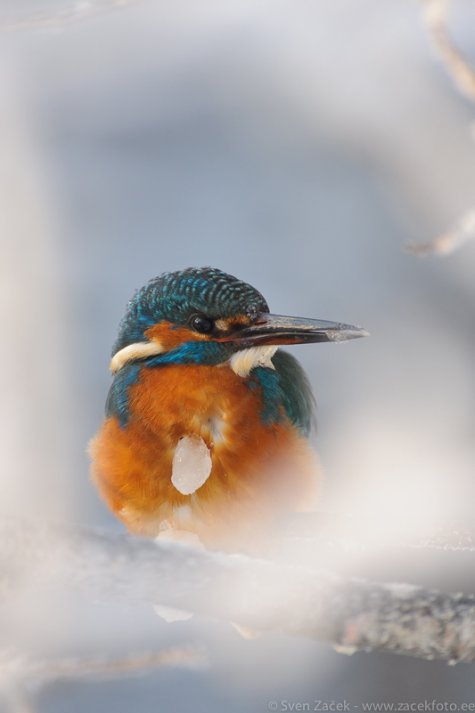Bird of the Year seen at the eco-rally
Story written by Tarvo
Photo: Sven Zacek, www.zacekfoto.ee
Translation: Liis
Bird of the Year - kingfisher
The Bird of the Year 2014, defying the cold, made it on to the cover of the year’s first "Eesti Loodus" issue: http://www.loodusajakiri.ee/tutvustused/EL01_2014.pdf (in Estonian).
Encounter with the Bird of the Year:
Harsher frosts have finally arrived. At sunrise in the morning when I after a long time once again set out on an eco-trip, the thermometer showed 12 degrees of cold.
The main goal of today’s trip was to evaluate the number of wintering waterfowl in Haapsalu within the frame of the midwinter waterfowl census. It should be noted that the midwinter waterfowl census is the most long-term monitoring project of the Estonian Ornithological Society, and has been regularly carried out already since 1967. The point of the census is very simple – in wintering areas where the birds are more densely gathered it is possible to evaluate the size and welfare of their populations.
A couple of cold nights had done their work and today’s official measurements already gave an ice thickness on Tagalahe bay of 12 cm. Firstly I of course set off towards the Haapsalu waterworks. On the previous day Alpo had met a kingfisher here and this would be a nice addition to my eco year.
At the sedimentation ponds I did find a number of ducks to be sure. Mallards were of course most numerous but they were only 35 here. In better winters a couple of hundred mallards have wintered here. The species mix however is interesting for midwinter – on the ponds a female gadwall was busy and a solitary male wigeon also showed up. Although they were quite good finds for the month of January, I already had these species noted on my list since early January.
Around the open wastewater pipe total silence reigned to my great disappointment. Nothing except some blue tits. Next I set out to scan the bay edge. To begin with I saw an old white-tailed eagle circling. Perhaps this was the reason why so few ducks were to be seen today? Quite soon however I heard the characteristic cheeping of bearded tits. Finally I had this species noted.
On the way back I decided to check the sewers once more. As a pleasant surprise this time a solitary kingfisher flew up from a reed stem directly beside the pipe. This bird, selected by EOÜ as bird of the year, can be considered the best observation up to now in the eco year. During the breeding season this bird isn’t to be seen in the Haapsalu vicinity so the best opportunity to see the species is in winter or in passing during migration.
Going on I set sight on the other edge of the city, to the Jaama creek outflow, where only a few days ago 16 grey herons hunched. Having got there it turned out that in the intervening nights the whole estuary area had frozen, and there were no herons nor any wintering waterfowl. Since the creek itself was not frozen, I decided next to tramp along the bank for a few kilometres. Years ago I have even seen the dipper here once, and getting this winter visitor noted in Haapsalu would be a real triumph. Kilometres added up, but sadly that cannot be said for species as well. Finally I at least succeeded in having the first goldfinches of the year rise into flight from the water’s edge.
Trudging around at the Jaama creek didn’t bring any more points, and I set out towards home through the garden city. In the city too only the common species noted already long ago caught attention. Some hundred meters before getting home tits sounded an alarm, and the pigeons that had been walking on the pavement flew away in panic. It was clear that a bird of prey must be nearby. And quite soon the cause of the panic - a sparrowhawk - glided through the backyards at low height. It was nice to finish the ecotrip with the second bird of prey of the year.
In the first 17 days of the year 11 observation hours have been added up, and 27 km have been passed on foot. As of now I have noted 46 eco-points.









